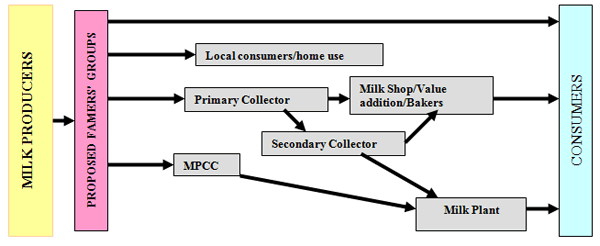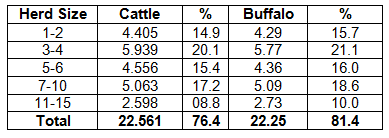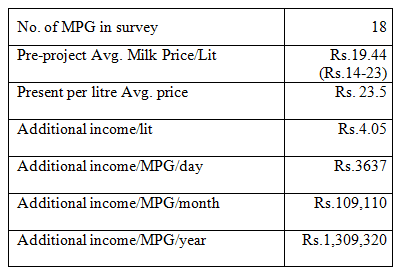Introduction
In developing countries small dairy holders play an important role in food security. In Pakistan more than 70% animals are owned by farmers having herd size of 1-10 animals. These farmers are back bone of our dairy industry that produces more than 70% of market milk supply. In case of livestock farming, the major % of dairy animals is raised by farmers having not more than 15 animals per farm. A significant percentage 76.4 (22.56 million) and 81.4 (22.25 million) of cattle and buffalo animals respectively, is kept by these small/landless farmers (table -1). The specific needs of these small farmers are always neglected by the policy makers. Thus, the major population of dairy animals and farmers playing significant role in milk supply for human consumption remains debarred from enjoying benefits allocated for big farmers.
Table 1: Herd Profile of Livestock in Pakistan
The small farmers keeping 51% animals are almost ignored by public sector. The high input cost, static milk prices, limited outreach programs and scantly animal care services hitting them hard. It is very difficult for small and landless dairy farmers to make their voices heard by the policy makers in presence of mega dairy players with lucrative advertisement and publicity. Under such circumstances only one solution is left, that is combing the resources and act jointly. That is why dairy cooperatives and organized farmers´ associations always able to fight back and protect members rights. By pooling the resources, the dairy cooperative has more power to deal market forces from purchase of inputs to sale of farm produce with better negotiation position.
The cooperative farming is not a new concept. It is a system "where in farmers voluntarily come together, pool their resources in buying inputs, using resources like land, water and market the produce and divide the earnings" or "System in which individual farmers pool their resources (excluding land) to buy commodities such as seeds and fertilizers, and services such as marketing. It is a system of farming found throughout the world and is particularly widespread in Denmark and the ex-Soviet republics." In a collective farm, land is also held in common.
The main benefits of cooperative farming go to small land holders or land less framers because by pooling their resources and market their produce collectively they achieve strong negotiation power resultantly better prices. But it is not easy to establish cooperatives in a short period of time whilst being comprised of members of different economic, social and cultural heritage. To stimulate people, bring them on common benefit agenda, sharing the responsibilities, equal rights of every member and fair distribution of profits and benefits is not an easy task. Normally it takes 10 to 12 years to develop a sustainable cooperative system and during this period, the resource person should have continuous contact with these societies.
To establish a cooperative, identification of mutual interest group is very important. The group formation is only encouraged when members are willing to join group, Potential members are living near to each other, Trust between the potential members, Potential members have the same social and economic background and Men & women have the same rights. The important incentives that play major role in forming the common interest group are more income, economics of sale, better access to outside support services, risks are shared, learn from each other, development and enforcement of rules, social support and saving of time. It is important that target communities should participate fully for sustainable development. Their participation is a key factor because they have full information and can help in planning a successful program, achieving its goals, Situation analysis, have local Knowledge, Experience with technologies and are part of Social structure of the society. The seven (7) golden rules that a successful cooperative must bear are;
- Voluntary and open membership
- Democratic Member Control
- Member Economic Participation
- Autonomy and Independence
- Education
- Training and Information
- Cooperation among Milk Producer Group and Concern for Community.
A Case Study in Pakistan: (Small Dairy Holders Marketing Model (SDHMM)
The milk marketing for small dairy farmers (SDM) is main problem. Due to small amount of milk to sell farmers are unable on harvest better price on individual basis. Having left no other alternatives and perishable nature of product are forced to sell whatever price offered to them by local milk collector. The all possible marketing channels are given in Fig 1. The % of flow of milk in these channels keeps on changing according to the seasonality in production, local demands, traditional use etc. The only organised segment of above mentioned team is processing industry. The consumers and producers both have got no voice due to absence of their organizations.
Fig 1: Marketing Options for SDH (MPCC: Milk Plant Collection Centres)

To offer a workable solution for SDH, a model was proposed. Under this model local farmers were gathered and organized in groups called "Milk producer groups" (MPGs). In formation of these groups cluster approach was applied. The farmers´ representatives were elected by farmers to run association business by themselves. Only those farmers were offered membership who agreed to bring at least one time milk to community collection centre for collective sale. In this model instead of selling small amount of milk individually directly to middle men/primary milk collector, milk is pooled at community centre and sold on better price to collectors through bargaining made by MPG office bearers (as shown in Fig 1: proposed farmers group). In this way farmers have got power to negotiate for better price due to their collective approach and substantial amount of milk to sell. Both the parties has win win situation. The collector gets handsome quantity of milk at one point with out wasting time and resources and farmers get fair price of their produce. The beauty of this model is that instead of crowding out and competing with middleman (as previously thought), he was compelled to pay fair price to farmers from his profit. In this way the gape between producers and consumers price was reduced. The direct marketing of milk from producer to consumers is practically not possible. Only in case of peri-urban SDH, a limited milk amount (where distance is not more than 5-0 Km) can be directly sold to households. There was no binding on farmers associations to sell milk. They were free to sell milk any purchaser who pays more price whether he is private collector, bulk purchaser or represents milk processing plants.
The extra price received was mainly used for better inputs to improve milk production. For milk collection, cool chain was established by providing cooling tanks to each group. For maintenance of cool chain, a small amount Rs. 0.50 – 1.0 per litre was deducted from farmers. Each centre was provided milk quality test equipments. To improve animals´ health and awareness to members about better husbandry practices, on recommendations of group office bearers, two youths from each milk collection centre were trained in animal first aid, vaccination, management, A.I., milk quality tests and record keeping. At each centre basic facilities viz., quality fodder seed, concentrate and medicines were sold to group members´ at marginal profit. The payments can be made in form of milk or in instalments. To educate the farmers, each group was provided training at doorstep to save farmers time. The more income has played a significant role in socioeconomic status and awareness.
The value addition is another factor that has increased the income of cooperative groups. After training, groups are processing milk in to Yoghurt, cheese and butter. These products are being sold at much higher prices (100% more). Surprisingly, all such groups are being maintained by the women.
Fig 2: SDHMM Model
The success of present case study indicates that to address the problems of small and landless farmers "Milk Cooperatives" are the only best option. The impact assessment revealed that farmers were getting on an average 25% more price than non-project areas (table 2).
Table 2- Impact of Project on Farmers Income
Lesson Learnt
It was learnt direct milk marketing for SDH is not feasible. In stead of competing/eliminating middleman, he should be fore to pay fair price and it is easy and workable solution. Farmers association should be free of bureaucracy control and run by their own organizations. Availability of improved input and facilities at proper time is very important.












.jpg&w=3840&q=75)